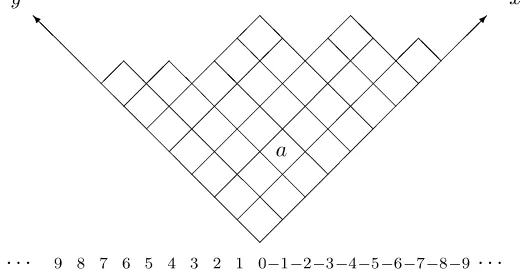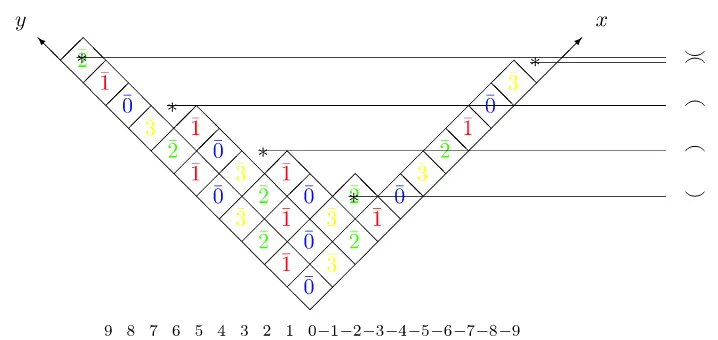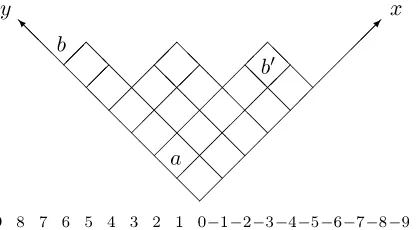Monomial Crystals and Partition Crystals
Peter TINGLEY
Department of Mathematics, Massachusetts Institute of Technology, 77 Massachusetts Avenue, Cambridge, MA 02139, USA
E-mail: [email protected]
URL: http://www-math.mit.edu/∼ptingley/
Received February 10, 2010, in final form April 12, 2010; Published online April 21, 2010 doi:10.3842/SIGMA.2010.035
Abstract. Recently Fayers introduced a large family of combinatorial realizations of the fundamental crystalB(Λ0) forslbn, where the vertices are indexed by certain partitions. He showed that special cases of this construction agree with the Misra–Miwa realization and with Berg’s ladder crystal. Here we show that another special case is naturally isomorphic to a realization using Nakajima’s monomial crystal.
Key words: crystal basis; partition; affine Kac–Moody algebra
2010 Mathematics Subject Classification: 17B37; 05E10
1
Introduction
Fixn≥3 and let B(Λ0) be the crystal corresponding to the fundamental representation ofslbn.
Recently Fayers [2] constructed an uncountable family of combinatorial realizations ofB(Λ0), all of whose underlying sets are indexed by certain partitions. Most of these are new, although two special cases have previously been studied. One is the well known Misra–Miwa realization [12]. The other is the ladder crystal developed by Berg [1].
The monomial crystal was introduced by Nakajima in [13, Section 3] (see also [5,10]). Nakaji-ma considers a symmetrizable Kac–Moody algebra whose Dynkin diagram has no odd cycles, and constructs combinatorial realizations for the crystals of all integrable highest weight modules. In the case of the fundamental crystal B(Λ0) for slbn, we shall see that the construction works
exactly as stated in all cases, includingn odd when there is an odd cycle.
Here we construct an isomorphism between a realization ofB(Λ0) using Nakajima’s monomial crystal and one case of Fayers’ partition crystal. Of course any two realizations of B(Λ0) are isomorphic, so the purpose is not to show that the two realizations are isomorphic, but rather to give a simple and natural description of that isomorphism.
This article is organized as follows. Sections2,3and4review necessary background material. Section 5 contains the statement and proof of our main result. In Section 6 we briefly discuss some questions arising from this work.
2
Crystals
In Sections 3 and 4 we review the construction of Nakajima’s monomial crystals and Fayers’ partition crystals. We will not assume the reader has any prior knowledge of these constructions. We will however assume that the reader is familiar with the notion of a crystal, so will only provide enough of an introduction to that subject to fix conventions, and refer the reader to [9] or [6] for more details.
We only consider crystals for the affine Kac–Moody algebraslbn. For us, an slbn crystal is the
operators ˜e¯ı,f˜¯ı : B → B∪ {0} for each ¯ı modulo n, which satisfy various axioms. Often the
definition of a crystal includes three functions wt, ϕ, ε :B →P, where P is the weight lattice. In the case of crystals of integrable modules, these functions can be recovered (up shifting in a null direction) from the knowledge of the ˜e¯ı and ˜f¯ı, so we will not count them as part of the
data.
3
The monomial crystal
This construction was first introduced in [13, Section 3], where it is presented for symmetrizable Kac–Moody algebras where the Dynkin diagram has no odd cycles. In particular, it only works for slbn when nis even. However, in Section 5 we show that for the fundamental crystal B(Λ0)
the most naive generalization to the case of oddngives rise to the desired crystal, so the results in this note hold for all n≥3.
We now fix some notation, largely following [13, Section 3].
•LetIebe the set of pairs (¯ı, k) where ¯ı is a residue modn and k∈Z.
Definition 3.3. Let M(m) be the set of monomials in M which can be reached from m by applying various ˜e¯Mı and ˜f¯ıM.
Theorem 3.4 ([13, Theorem 3.1]). Assume n >2 is even, and letm be a dominant, compa-tible monomial. Then M(m) along with the operators e˜¯Mı and f˜¯ıM is isomorphic to the crystal B(wt(m))of the integrable highest weight slbn moduleV(wt(m)).
Remark 3.5. Notice that although Theorem3.4 only holds whenn is even, the operators ˜eM
¯
ı
Figure 1. The operators ˜eM
as shown above the monomial. The first uncanceled “)” from the right corresponds to a factor of Y−1 ¯
2,12m. The first uncanceled “(” from the left corresponds to a factor of Y¯1,9, sofe¯1M(m) =A−
We find it convenient to use the following slightly different but equivalent definition of ˜eM¯ı and ˜f¯ıM. For each ¯ı modulon, letS¯ı(m) be the string of brackets which contains a “(” for every
factor ofY¯ı,k inmand a “)” for every factor ofY¯ı,k−1 ∈m, for allk∈Z. These are ordered from
left to right in decreasing order of k, as shown in Fig. 1. Cancel brackets according to usual conventions, and set
It is a straightforward exercise to see that the operators defined in (2) agree with those in (1).
4
Fayers’ crystal structures
4.1 Partitions
A partitionλis a finite length non-increasing sequence of positive integers. Associated to a par-tition is its Ferrers diagram. We draw these diagrams as in Fig. 2 so that, if λ= (λ1, . . . , λN),
then λi is the number of boxes in row i (rows run southeast to northwest). LetP denote the
set of all partitions. For λ, µ∈ P, we sayλis contained inµif the diagram forλfits inside the diagram for µ.
Fix λ ∈ P and a box b in (the diagram of) λ. We now define several statistics of b. See Fig. 2for an example illustrating these. The coordinates ofb are the coordinates (xb, yb) of the
center of b, using the axes shown in Fig.2. Thecontent c(b) is yb−xb. Thearm length of b is
We now recall Fayers’ construction [2] of the crystalBΛ0 forslbn in its most general version. We begin with some notation. Anarm sequence is a sequence A=A1, A2, . . . of integers such that
(i) t−1≤At≤(n−1)t for allt≥1, and
(ii) At+u ∈[At+Au, At+Au+ 1] for all t, u≥1.
Fix an arm sequence A. A box b in a partition λ is called A-illegal if, for some t ∈ Z>0, hook(b) = nt and arm(b) = At. A partition λ is called A-regular if it has no A-illegal boxes.
Figure 2. The partition λ= (7,6,5,5,5,3,3,1), drawn in “Russian” notation. The parts λi are the lengths of the “rows” of boxes sloping southeast to northwest. The center of each boxb has coordinate (xb, yb) for somexb, yb ∈Z+1/2. For the box labeleda,xa = 2.5 andya = 1.5. The contentc(a) =ya−xa records the horizontal position ofa, reading right to left. In this case,c(a) =−1. Other relevant statistics are hook(a) = 8, arm(a) = 3 and h(a) = 4. This partition is not inBH forslb
4, since the boxa isAH
-illegal.
Forλ∈ P and a box b∈λ. Thecolor of b is the residue c(b) of c(b) modulo n, where as in Section 4.1,c(b) is the content ofb. See Fig. 3.
Fixλ∈ P and a residue ¯ımodulo n. Define
• A(λ) is the set of boxes b which can be added toλso that the result is still a partition.
• R(λ) is the set of boxesbwhich can be removed fromλso that the result is still a partition.
• A¯ı(λ) ={b∈A(λ) such thatc(b) = ¯ı}.
• R¯ı(λ) ={b∈R(λ) such thatc(b) = ¯ı}.
For each partition λand each arm sequence A, define a total order ≻A on A¯ı(λ)∪R¯ı(λ) as
follows. Fix b = (x, y), b′ = (x′, y′) ∈ A
¯ı(λ)∪R¯ı(λ), and assume b 6= b′. Then there is some
t ∈ Z\{0} such c(b′)−c(b) = nt. Interchanging b and b′ if necessary, assume t > 0. Define b′ ≻
Abify′−y > At, and b≻Ab′ otherwise. It follows from the definition of an arm sequence
that ≻A is transitive.
Fix a partitionλ. Construct a string of bracketsSA
¯ı (λ) by placing a “(” for everyb∈A¯ı(λ) and
a “)” for everyb∈R¯ı(λ), in decreasing order from left to right according to≻A. Cancel brackets
according to the usual rule. Define maps ˜e¯Aı ,f˜¯ıA:P ∪ {0} → P ∪ {0} by eA¯ı (0) =f¯ıA(0) = 0,
˜ e¯Aı (λ) =
(
λ\b if the first uncanceled “)” from the right inS¯ıA corresponds to b, 0 if there is no uncanceled “)” inSA
¯ı ,
˜ f¯ıA(λ) =
(
λ⊔b if the first uncanceled “(” from the left inS¯ıA corresponds to b, 0 if there is no uncanceled “(” inSA
¯
ı .
(3)
Theorem 4.1 ([2, Theorem 2.2]). Fix n ≥ 3 and an arm sequence A. Then BA∪ {0} is preserved by the maps e˜A
¯ı and f˜¯ıA, and forms a copy of the crystal B(Λ0) for slbn, where as
above BA is the set of partitions with no A-illegal hooks.
Remark 4.2. The operators ˜e¯ı and ˜f¯ı are defined on all partitions. However, as noted in [2],
4.3 Special case: the horizontal crystal
Consider the case of the construction given in Section4.2where, for allt,At=⌈nt/2⌉ −1 (it is
straightforward to see that this satisfies the definition of an arm sequence). This arm sequence will be denoted AH. For convenience, we denote BAH
simply by BH and the operators ˜eAH ¯ı
and ˜f¯ıAH from Section4.2by ˜e¯Hı and ˜f¯ıH.
Definition 4.3. Letb= (x, y) be a box. Theheight of bis h(b) :=x+y. Lemma 4.4. Fix λ∈BH, and letb, b′∈A
¯ı(λ)∪R¯ı(λ)withb=6 b′. Then b′≻AH bif and only if
(i) h(b′)> h(b), or
(ii) h(b′) =h(b) and c(b′)> c(b).
Proof . Since ¯c(b) = ¯c(b′), we havec(b′)−c(b) =ntfor somet∈
Z\{0}. First consider the case when t >0. Then by definition,b′ ≻
AH bif and only if
y′−y > AHt , (4)
where
AHt =⌈nt/2⌉ −1 =⌈(c(b′)−c(b))/2⌉ −1 =⌈(y′−x′−y+x)/2⌉ −1
= (
(y′−x′−y+x)/2−1 ify′−x′−y+x is even, (y′−x′−y+x)/2−1/2 ify′−x′−y+x is odd.
Since y′−y∈
Z, (4) holds if and only if y′−y >(y′−x′−y+x)/2−1/2, which rearranges to h(b′)≥h(b).
The caset <0 follows immediately from the caset >0 since ≻AH is a total order.
Lemma4.4implies that ˜e¯Hı and ˜f¯ıH are as described as in Fig.3.
5
A crystal isomorphism
Define a map Ψ :P ∪ {0} → M ∪ {0} by Ψ(0) = 0, and, for allλ∈ P,
Ψ(λ) := Y
b∈A(λ)
Yc¯(b),h(b)−1 Y
b∈R(λ) Y−1
¯
c(b),h(b)+1.
Here A(λ) and R(λ) are as in Section 4.2.
Theorem 5.1. For any n≥3, any¯ı modulo n, and any λ∈BH, we have Ψ(˜e¯Hı λ) = ˜eM¯ı Ψ(λ) and Ψ( ˜f¯ıHλ) = ˜f¯ıMΨ(λ), where ˜eM¯ı , f˜¯ıM are as in Section 3 and e˜¯Hı , f˜¯ıH are as in Section 4.3.
Before proving Theorem5.1we will need a few technical lemmas.
Lemma 5.2. Let λ and µ be partitions such that µ = λ⊔b for some box b. Then Ψ(µ) = A−c(1b),h(b)Ψ(λ).
Proof . Let i= ¯c(b). It is clear that the pair (A(λ), R(λ)) differs from (A(µ), R(µ)) in exactly the following four ways:
• b∈A¯ı(λ)\A¯ı(µ).
Figure 3. The partitionλ= (11,7,4,2,1,1,1,1,1,1) is an element ofBH forslb
from left to right lexicographically, first by decreasing height h(b), then by decreasing content c(b). The result is shown on the right of the diagram (rotate the page 90 degrees counter clockwise). Thus ˜f¯2(λ)
is the partition obtained by adding the box with coordinates (x, y) = (10.5,0.5). The map Ψ from
3,11. After reordering and simplifying,
this becomesY−1
2 (λ), except that a canceling pair () has been removed. The condition thatλhas noA
H-illegal
boxes implies thatSH
¯
ı (λ) andS¯ıM(Ψ(λ)) are always the same up to removing pairs of canceling brackets, which is essentially the proof that Ψ is an isomorphism.
• Either (i): A¯ı+¯1(µ)\A¯ı+¯1(λ) = b′ and R
By the definition of Ψ, this implies
Ψ(µ) =Y¯ı,h−1(b)−1Y¯ı,h−1(b)+1Y¯ı+¯1,h(b)Yı¯−¯1,h(b)Ψ(λ) =A
same column, which implies that there is a unique boxainλwhich shares a row or column with each of b, b′. It is straightforward to see that if (i) or (ii) is violated then this a is AH-illegal
(see Fig.4).
To see part (iii), recall that by Lemma 4.4, b ≻AH b′ if and only if h(b) > h(b′) or both
Figure 4. The hook defined byb∈A¯ı(λ) andb′∈R¯ı(λ). There will always be a unique boxainλwhich is in either the same row or the same column asband also in either the same row or the same column asb′.
Takingn= 3, we haveb∈A¯0(λ) andb′∈R¯0(λ). Then hook(a) = 9 = 3×3 and arm(a) = 4 =AH3, so a
isAH-illegal. It is straightforward to see that in general, if either (i):h(b) =h(b′) + 1 or (ii):h(b) =h(b′)
andc(b)> c(b′), then the resulting hook isAH-illegal, and henceλ /∈BH.
Part (iv) and (v) follow because any other c ∈ A¯ı(λ)∪R¯ı(λ) with b ≻AH c ≻AH b′ would
violate either (i) or (ii).
Proof of Theorem 5.1. Fixλ∈BH and ¯ı∈Z/nZ. LetS¯ıM(m) denote the string of brackets used in Section 3to calculate ˜e¯Mı (m) and ˜f¯ıM(m). LetS¯ıH(λ) denote the string of brackets used in Section4to calculate ˜eH
¯
ı (λ) and ˜f¯ıH(λ), and define the height of a bracket inS¯ıH(λ) to beh(b)
for the corresponding box b∈A¯ı(λ)∪R¯ı(λ).
By Lemma 5.3 parts (iv) and (v), for each k ≥ 1, all “(” in S¯ıH(λ) of height k+ 1 are immediately to the left of all “)” of height k−1. LetT be the string of brackets obtained from S¯ıH(λ) by, for each k, canceling as many “(” of heightk+ 1 with “)” of heightk−1 as possible. Notice that one can useT instead ofS¯ıH(λ) to calculate ˜eıH¯ (λ) and ˜f¯ıH(λ) without changing the result.
By the definition of Ψ, it is clear that
(i) The “(” inT of height k+ 1 correspond exactly to the factors of Y¯ı,k in Ψ(λ).
(ii) The “)” inT of height k−1 correspond exactly to the factors ofY¯ı,k−1 in Ψ(λ). Thus the brackets in T correspond exactly to the brackets in SM
¯ı (Ψ(λ)). Furthermore,
Lemma 5.3 part (iii) implies that these brackets occur in the same order. The theorem then follows from Lemma 5.2and the definitions of the operators (see equations (2) and (3)).
Corollary 5.4. For any n, M(Y¯0,0) is a copy of the fundamental crystal B(Λ(0))for slbn.
Proof . This follows immediately from Theorem 5.1, since, by Theorem 4.1, BH is a copy of
the crystal B(Λ0).
6
Questions
the Misra–Miwa realization. The Misra–Miwa realization corresponds to one case of Fayer’s partition crystal, but not the one studied in Section4.3. In [10], there is some choice as to how the monomial crystal is modified. Do other modifications also correspond to instances of Fayers crystal? Which instances of Fayers’ partiton crystal correspond to modified monomial crystals (or appropriate generalizations)?
Question 3. The monomial crystal construction works for higher level slbn crystals. There are
also natural realizations of higher level slbn crystals using tuples of partitions (see [3,7,8,14]). Is there an analogue of Fayers’ construction in higher levels generalizing both of these types of realization?
Acknowledgments
We thank Chris Berg, Matthew Fayers, David Hernandez and Monica Vazirani for interesting discussions. This work was supported by NSF grant DMS-0902649.
References
[1] Berg C., (ℓ,0)-JM partitions and a ladder based model for the basic crystal ofslbℓ,arXiv:0901.3565.
[2] Fayers M., Partition models for the crystal of the basicUq(slbn)-module,J. Algebraic Combin., to appear, arXiv:0906.4129.
[3] Foda O.,, Leclerc B., Okado M., Thibon J.-Y., Welsh T.A., Branching functions ofA(1)n
−1and Jantzen–Seitz problem for Ariki–Koike algebras,Adv. Math.141(1999), 322–365,q-alg/9710007.
[4] Frenkel E., Reshetikhin N., Theq-characters of representations of quantum affine algebras and deformations of W-algebras, in Recent Developments in Quantum Affine Algebras and Related Topics (Raleigh, NC, 1998),Contemp. Math., Vol. 248, Amer. Math. Soc., Providence, RI, 1999, 163–205,math.QA/9810055.
[5] Hernandez D., Nakajima H., Level 0 monomial crystals, Nagoya Math. J. 184 (2006), 85–153, math.QA/0606174.
[6] Hong J., Kang S.-J., Introduction to quantum groups and crystal bases,Graduate Studies in Mathematics, Vol. 42, Amer. Math. Soc., Providence, RI, 2002.
[7] Jimbo M., Misra K.C., Miwa T., Okado M., Combinatorics of representations of Uq(slb(n)) atq= 0,Comm.
Math. Phys.136(1991), 543–566.
[8] Kang S.-J., Lee H., Higher level affine crystals and Young walls,Algebr. Represent. Theory9(2006), 593– 632,math.QA/0310430.
[9] Kashiwara M., On crystal bases, in Representations of Groups (Banff, AB, 1994),CMS Conf. Proc., Vol. 16, Amer. Math. Soc., Providence, RI, 1995, 155–197.
[10] Kashiwara M., Realizations of crystals, in Combinatorial and Geometric Representation Theory (Seoul, 2001),Contemp. Math., Vol. 325, Amer. Math. Soc., Providence, RI, 2003, 133–139,math.QA/0202268.
[11] Kim J.-A., Monomial realization of crystal graphs forUq(An(1)),Math. Ann.332(2005), 17–35.
[12] Misra K., Miwa T., Crystal base for the basic representation of Uq(slbn), Comm. Math. Phys.134(1990), 79–88.
[13] Nakajima H., t-analogs ofq-characters of quantum affine algebras of typeAn,Dn, in Combinatorial and Geometric Representation Theory (Seoul, 2001),Contemp. Math., Vol. 325, Amer. Math. Soc., Providence, RI, 2003, 141–160,math.QA/0204184.
[14] Tingley P., Three combinatorial models forbslncrystals, with applications to cylindric plane partitions,Int.


